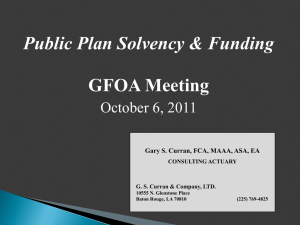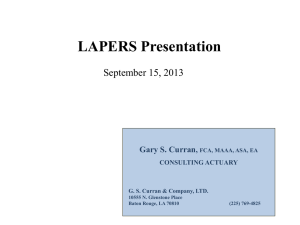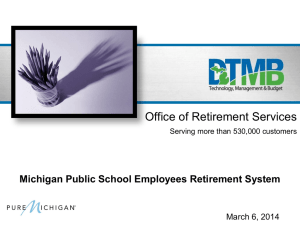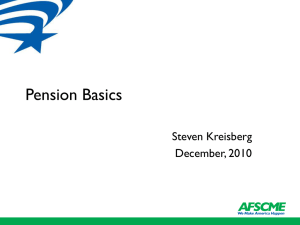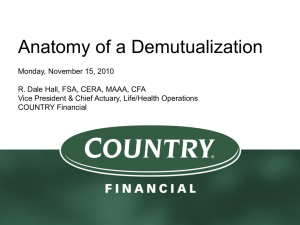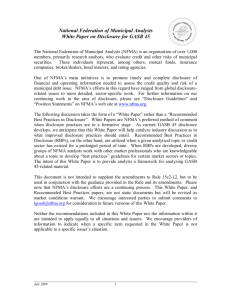How to Read an Actuarial Valuation Report
advertisement
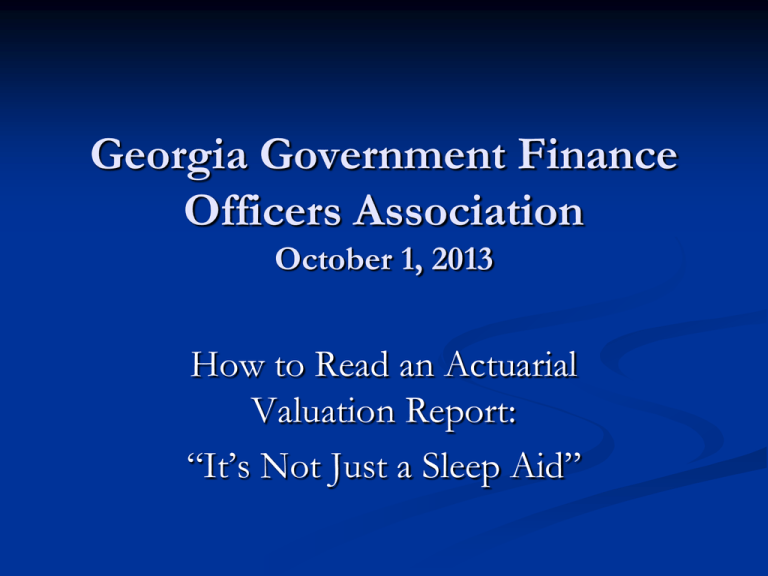
Georgia Government Finance Officers Association October 1, 2013 How to Read an Actuarial Valuation Report: “It’s Not Just a Sleep Aid” Speaker Alisa Bennett, Principal and Consulting Actuary, Cavanaugh Macdonald Consulting, LLC. Kennesaw, GA Over 20 years of Public Sector Actuarial Experience Consult with many GA Plans 2 Table of Contents Actuarial Jargon Main Purposes of the Valuation Report Funding Requirements Assets Gain/Loss GASB Accounting Assumptions 3 Actuarial Jargon Actuarial Communication – Actuarial Standards of Practice (ASOPs) MVA PVFB EAN PUC AAL NC UAAL AVA ARC NPO GASB OPEB 4 Main Purposes of Valuation Report Provide a summary of the funded status of the Pension or OPEB Plan. Recommend rates of contribution. Provide accounting information under GASB 25 and 27 (soon to be 67 and 68) and/or 43 and 45 for OPEB for Plan’s Comprehensive Annual Financial Reports (CAFR). 5 Main Purposes of Valuation Report Provide summary of participant data as of snapshot valuation date. List all Assumptions and Methods that went into developing liabilities. Provide summary of Plan Provisions. 6 Funding Valuation Process Present Value of Future Benefits (PVFB) Actuarial Accrued Liability (AAL) Assets (AVA, MVA) Unfunded Accrued Liability (UAL) Future Normal Costs (NC) Member Portion Employer Portion 7 Present Value The present value of an amount of money payable in the future is the amount of money that, if we had it today, would accumulate to the amount that will be payable considering: Investment Return Probability that money will be paid 8 Present Value Example 1: You owe $1,000 to a financial institution payable one year from now. You estimate you can invest money for a 7% return. What is the present value of the debt? $1,000 / 1.07 = $934.58 9 Present Value Example 2: You owe $1,000 to a person payable one year from now. The person is 70 years old and has no heirs. You estimate you can invest money for a 7% return. You estimate that the chance the person is still alive one year from now is 98%. What is the present value of the debt? $1,000 / 1.07 x 98% = $915.89 Observation: If the person dies, you will have money left over. If the person lives, you won’t have enough money to pay the debt. 10 Normal Cost Contribution For Description Future Normal Costs Value of all future expected benefit accruals Normal Cost Rate Value of this next year’s expected benefit accruals as a percent of payroll Total Normal Cost Rate 12.00% Employee Rate (8.00)% Employer Normal Cost Rate 4.00% 11 Actuarial Accrued Liability The portion of the present value of pension plan benefits not provided for by future normal costs. 12 Asset Valuation Methods Market Value of Assets (MVA) Smoothed Market – Actuarial Value of Assets (AVA) 13 Smoothing Methods Recognize some portion of market return each year Can be straight line or weighted Most commonly used is straight line, 5-year smoothing Can be with or without corridor, i.e., actuarial value cannot be less than x% or more than x% of market value Most common corridor is 80%-120% of market value 14 Actuarial Value vs. Market Value Actuarial Value of Assets is expected to be: • Higher than Market Value when market is doing poorly • Lower than Market Value when market is doing well 15 Unfunded Accrued Liability Contribution Rate Contribution For Unfunded Accrued Liability (UAL) Description Actuarial Accrued Liability – Actuarial Value of Assets “Unfunded Accrued Liabilities” are a natural part of retirement system funding comparable to a mortgage on a home. A plan which is 100% funded is required to contribute only the normal cost. Funding Ratio (or Funded Status) of the Plan is the ratio of Actuarial Value of Assets divided by the Actuarial Accrued Liability. If the Plan has a 100% Funding Ratio, there is no Unfunded Accrued Liability. 16 Unfunded Accrued Liability Amortization Level $ Level % of payroll Closed period Open or rolling period Maximum 30 years (GASB requirement) 17 Level $ Amortization Same as paying a home mortgage on a fixed interest rate. Payments remain constant in dollar amount over the amortization period, but decline as a percent of a, presumably, growing payroll. UAL declines in nominal (total dollar) value every year. 18 Level $ Amortization 19 Level % Amortization Developed to help better achieve the goal of level contributions as a percent of payroll. Requires an assumption regarding annual total payroll growth. GASB permits this method as long as growth in the active membership is not reflected in the payroll growth assumption. However expected declines in membership (e.g., closed plans) should be reflected. This results in the use of the wage inflation assumption for ongoing plans. 20 Level % Amortization 21 Closed vs. Open Periods Closed period means a one year drop in the amortization period each year until you reach zero. Open period means the amortization period fluctuates up or down, or stays the same from year to year. Open period with level % amortization can result in never paying off the UAL, although it does decline as a percent of payroll. 22 Open Period UAL Dollar Amount 23 Open Period UAL as % of Payroll 24 Funding Ratio Comparison 25 Annual Required Contributions (ARC) Contribution For Employer Rate Total Normal Cost Rate 12.00% Employee Rate (8.00%) Employer Normal Cost Rate 4.00% Unfunded Accrued Liability Rate (amortized over 30 year period) 6.00% Annual Required Contribution Rate 10.00% 26 Causes of Unfunded Accrued Liabilities Granting initial benefits or granting benefit increases for service already rendered. Actual experience which is less favorable than assumed. Examples follow: a. b. c. d. e. Higher salary increases Earlier retirement date(s) Lower death rates Lower rates of investment earnings Lower rates of non-death terminations 27 Changes in Major Assumptions Effect on Liabilities and Contributions Assumption Action Usual Effect on UAL Long Term Investment Rate Increase Decrease Retire Younger Increase Turnover Rates More Terminations Decrease Salary Increases Higher than Normal Increase Retirement Rates 28 GASB Accounting Information Disclosure for GASB 25 and 27 (soon to be 67 and 68) and/or 43 and 45 for OPEB Valuations Distribution of Number of Employees by Type of Membership Schedule of Funding Progress Schedule of Employer Contributions Calculation of Net Pension Obligation (soon to be Net Pension Liability (NPL) and/or Net OPEB Obligation Solvency Test 29 Schedule of Funding Progress Six Year History of the following: Actuarial Value of Assets Actuarial Accrued Liability Unfunded Accrued Liability (UAL) Funded Ratio Covered Payroll UAL as a Percent of Covered Payroll 30 Schedule of Employer Contributions Six Year History of the following: Annual Required Contributions (ARC) Percent of ARC Contributed 31 Net Pension Obligations (NPO) Net OPEB Obligations (NOO) If the ARC is not contributed each year by the Employer, the Plan must disclose a liability on the financial statements to recognize this obligation. 32 Solvency Test Displays the Portion of the Accrued Liabilities that are covered by the Assets in Percentage Form Liabilities broken down into 3 components: 1) 2) 3) Active Member Contributions Retirees, Survivors and Inactive Liabilities Active Members (Employer Provided Benefits) 33 Selecting Assumptions Demographic Economic Specific to OPEB 34 Demographic Withdrawal Death in active service Disability Retirement Death after retirement Special Terminations (e.g. Shutdowns) Spouse Assumptions 35 Demographic Adjustments Experience Investigations Compares actual plan experience with actuarial assumptions used in the valuation Performed every 3-5 years Follow experience Watch trends (e.g. Improving Mortality) Factor in special events (e.g. re-employment legislation) 36 Economic Assumptions Inflation should be consistently applied Asset return Salary increases COLAs Real returns should reflect asset mix 37 Understanding Economic Assumptions Interest Rate - Inflation Rate = Real Rate of Return Interest rate determines how much money we think we'll have. Inflation rate tells us what we think it will buy. 38 Other Economic Assumptions Salary increases Current & anticipated practice Collective bargaining agreements Single rate Age and/or service related Cost of Living Adjustments (COLAs) Inflation related Percent determined by plan 39 Assumptions Specific to OPEB Healthcare Trend Applied annually to the plan’s assumed per member claims cost. Considers such things as price inflation, leverage (the effect of fixed co-payments and deductibles), future utilization and cost shifting, legislative and technological changes. 40 Assumptions Specific to OPEB Healthcare Trend (continued) Recent experience indicates very high medical inflation rates outstripping both salary and general inflation rates, but these are generally expected to level off. Affordable Care Act (ACA) Excise tax on high-value health insurance plans beginning in 2018 (if applicable), Mandated benefits and Participation changes due to the individual mandate/exchanges Overall future plan costs and the resulting liabilities are driven by amounts employers and retirees can afford (i.e., 41 trend). Assumptions Specific to OPEB Participation Most post-employment health plans require retirees to pay part of the premium. What percent will pay the premium and participate – what percent will waive coverage? Depends on the premium the retiree is required to pay. May depend on age and/or service at retirement. Affordable Care Act (ACA) Exchanges Participation changes due to the individual mandate 42 Questions ??? Alisa Bennett Cavanaugh Macdonald Consulting 678-388-1703 alisab@cavmacconsulting.com
